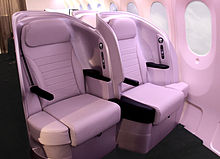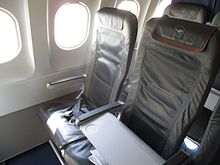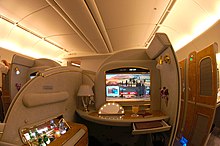Class of carriage
Most airlines differentiate air travel into three or four main classes of transport (also called classes of service or seat classes ): Economy, Premium Economy, Business and First / First. These, in turn, are divided into different booking classes , which vary in price and booking or travel conditions. The classes of transport differ in terms of service and comfort before, during and after the flight, as well as in price - but they also differ depending on the aircraft and airline.
The transport classes in detail
Economy class
Economy Class or Economy for short (English for economy , thriftiness ), popularly also wood class or tourist class , is the lowest class of transport.
The main requirement is to transport as many passengers as possible at the lowest possible cost. The economy therefore only includes a few services and comforts. Often more than 71% of the available seats on a flight are reserved for economy bookings, with low-cost airlines or charter airlines and on short-haul routes there is usually only this one class of travel. Economy Class seats are also often staggered in their prices: bookings made early receive a low rate, while bookings made when the flight is almost fully booked can be more expensive. In addition, the various price categories vary in their flexibility. A cheap ticket can usually not be rebooked or canceled, or only at high additional costs, while these changes are cheaper or free of charge in more expensive tariffs. On long-haul flights, most airlines offer each passenger a personal screen on which they can individually select films and music. Some older aircraft do not have this screen, but films can usually be viewed on several monitors on the cabin ceiling. On long-haul flights, economy passengers receive free care products less often than in Business and First Class, but mostly a pillow, headphones for the entertainment system, a blanket and sometimes socks. On almost all long-haul flights, Economy Class also has one or more free meals, as well as alcoholic and non-alcoholic beverages, depending on the duration of the flight.
Economy Plus
Some airlines offer special seats in the front area of economy class. However, these seats are often only characterized by a little more legroom or a larger selection of alcoholic beverages and do not represent a cabin class of their own. To differentiate these seats are often referred to as "Economy Plus" and not "Premium Economy".
Premium Economy Class

As early as 1991, EVA Air from Taiwan offered a fourth class, the Elite Class or Evergreen Deluxe Class. Over the years, other airlines followed this example and planned the Premium Economy Class for new orders for some types of aircraft. Over 50 airlines worldwide currently offer this service. Premium Economy Class differs from airline to airline. 10 to 15 cm more legroom than in Economy Class and more comfortable seats are the norm. There are also extra benefits such as increased baggage allowances , preferred check-in and boarding , ergonomically designed seats, adjustable head and leg rests, In-flight Entertainment , LCD - touch screen , send and receive emails and SMS , Free WiFi , 110- V socket , satellite phone in seat, menu choices served on china , travel necessaire , etc.
Business class

Business class is the second highest class of transport and is specially designed for business travelers. The main requirement is to get the traveler rested to their destination, to enable them to work while on the move and to minimize the time required. Compared to economy class, business offers a higher range of services as well as better quality and a larger selection of food and drinks. Business class booked passengers can e.g. B. Check-in before the flight at counters reserved for this booking class, wait in a separate queue at the security check (" Security Fast Lane ") and take a seat in lounges , receive higher quality meals during the flight and your luggage in front of the after the flight Economy Class passengers (" Priority Baggage ").
On long-haul flights, there is often the option of converting the seat into a lounger to allow passengers to sleep. However, the large seat spacing required for this would lead to insufficient capacity, which is why there are several methods of saving space and still giving passengers a good night's sleep and a private atmosphere. In the past, the loungers were often not horizontal, but slightly inclined so that the legs have space under the front seat ( angled lie-flat seats , for example Lufthansa ). Some airlines also install inclined seats ( herringbone or herringbone arrangement), which allow a horizontal reclining position and direct access to every seat from the aisle, but make the view of the window and communication between the travelers more difficult (e.g. Air Canada ). Another option is for the seats to be positioned in a 1-2-1 configuration. When the seats are in a 180 ° position (“flat bed”), the legs are positioned under the “closet” on the side of the person in front. This enables extra stowage space for the passenger due to its "closet" and direct access to the aisle (examples Etihad , Thai Airways ). Another seating arrangement is the so-called "v-configuration", in which you have two seats that are either inclined from one another or towards one another. If these seats are now made into a bed, the feet of the passenger will find space under the “closet” of the front men. This “closet” is located between the “v”, (examples: Qatar Airways , Lufthansa). With British Airways , half of the seats are rearranged to give a 2-4-2 configuration.
On domestic flights, on the other hand, the economy and business class seats are more often only separated from each other by a curtain and do not differ significantly in terms of seats or seat spacing. Instead, it often happens that the middle seat of a row of three is kept free. This is even the rule with the renowned Central European airlines. With three-row seating, the middle seats are then e.g. B. built over with a table, with only two-row seating, the aisle seat is not occupied. This higher level of service is associated with a higher flight price compared to economy. In addition, the range of amenities varies greatly between different aircraft, flights and airlines.
First class
First Class is the highest class of transport. It is usually only offered on long-haul flights in large aircraft such as the Boeing 747 , Boeing 777 , Airbus A340 , Airbus A350 or Airbus A380 , offers all the services and comforts of business and also some special features, without the compromises described there to save space. Most of the first class seats are made of exclusive materials such as leather and precious wood. Thus, the amounts to pitch in long-haul flights of Lufthansa First Class more than two meters, 1.5 meters in business class and 79 inches in Economy Class.
The main requirement is to minimize the inconvenience caused by a flight within the scope of what is technically feasible - while accepting considerable additional costs. If possible, even the trip should be an experience, e.g. B. through top gastronomy on board. The price for a seat in First is usually at least twice as high as in Business and sometimes ten times as high as in Economy Class. In addition, the offer varies greatly, depending on the route, aircraft type and airline. Some airlines, such as Singapore Airlines in the Airbus A380 and Emirates in the Airbus A380-800 and the Boeing 777-300ER, offer closed single and double cabins with full beds in First Class - these are often referred to as suites and have a lockable one Door. However, these cabins can be viewed from above for safety reasons.
Etihad has been offering an apartment on a commercial aircraft for the first time since 2015 with The Residence .
various
Airlines in the United States or the People's Republic of China, in particular, generally only offer first class and economy on domestic flights. The first class has particularly comfortable seats (four seats per row in the Boeing 737 or Airbus A320 ). Accordingly, business class passengers are also booked into First Class on their domestic American connecting flights.
Since the terms for the transport classes are not standardized, airlines occasionally offer completely different class names. B. Air Canada offers the business class "Executive First", but does not offer (further) "First Class" like the other airlines. In addition, some companies introduced their own brand names for certain classes, for example the Royal Silk Class as the business class of Thai Airways . The comparison with other airlines results from the booking codes .
differences

The differences between Economy Class on the one hand and First or Business Class on the other are very large. There are usually some advantages when booking First or Business Class over Economy Class. Mostly, travelers in the higher-quality transport classes are given higher free baggage allowances or lower surcharges for excess baggage or bulky items, while handling takes place at separate check-in counters with preferential treatment. Business and first class passengers also receive their baggage before economy class passengers when they return their baggage at their destination as part of a "priority baggage" rule.
During the waiting time before departure, most airlines offer free access to lounges or consumption vouchers for airport restaurants. When boarding, business and first-class passengers are usually allowed to board before the other passengers.
During the flight, a trip in a higher class is characterized by a larger selection of newspapers and magazines, higher quality catering with menus, higher quality crockery (e.g. chinaware , wine glasses , textile serviettes ) and an individually served menu. In addition, the larger number of flight attendants per passenger means that passengers are looked after more intensively.
The seat design in Business and First Class also differs significantly from that of Economy Class on medium and long-haul routes; the higher the transport class, the more comfortable the spacing between seats and armchairs (distances to the front and to the side, angle of inclination, cover). From the business class onwards, more and more airlines are offering so-called lie-flat seats , which can be set completely flat, sometimes even horizontally (fully flat) and thus represent a temporary bed. In the "First", such seats are already standard on long journeys and are often upgraded with a mattress.
Last but not least, more miles are often credited to the corresponding frequent flyer programs in higher classes .
In the case of short journeys, where you can hardly benefit from comfort features such as a more comfortable seat, the above-mentioned services make a significant difference.
Booking class codes
To assign a booking class to a flight booking, booking class codes are used, the so-called class codes or booking codes. The class codes do not usually appear in public, but are printed on the flight tickets and boarding passes, either as a single letter or as a capital letter composed of several asterisks.
The class codes do not always exactly match on all available documents. A Class Code Y (for Economy) can be specified on the ticket, while M is printed on the boarding pass. On the boarding pass, only the letter for the class of transport is sometimes indicated ( M or Y - Economy, C or J - Business, F - First).
The fact that there are several codes for the different classes is quite deliberate: How the codes are ultimately used depends solely on the airline in question. Efforts are being made to align the codes within an aviation alliance. For example, a code Y seat can B. can be awarded for 50 €, whereas a Code-M seat costs 120 € - nevertheless, both are economy seats.
On the other hand, a code that is used does not have to have any specific information about any quality features. The booking codes can also result in different rewards in frequent flyer programs : In the Miles & More program of Lufthansa , for example, intercontinental flights in class Y (economy) are reimbursed 1.5 times the distance, in class W, on the other hand, only half that Distance value taken into account. At the LH subsidiary Germanwings , some booking classes are completely excluded from earning miles. Germanwings was taken over by the Lufthansa subsidiary Eurowings.
The booking classes also have another function within the framework of the airline's yield management : Each booking class is linked to certain travel conditions that are not always published by the airlines. In particular, the deadline between booking and issuing the ticket, rebooking options, advance booking deadlines and stay requirements have a direct influence on the flight price.
See also
- Car class for classifying the railways.
Web links
- Seat tips for a number of types of aircraft or airlines (English)
- Website about the opportunities afforded products of many airlines (English)





